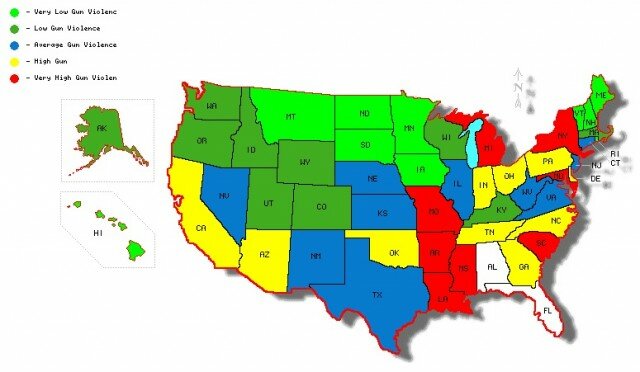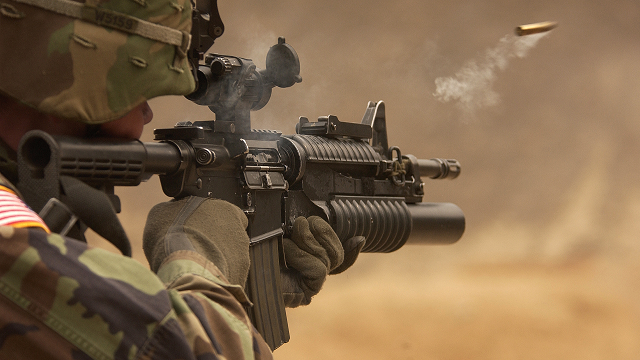One of the things that has troubled me in the gun control debate is this: is there any data that suggests that strict gun control laws actually produce results? Do gun control laws reduce murders? Do they even reduce gun murders? I decided to do some very rough research. Here’s what I found.
First, I went to the website of the Brady Campaign to Prevent Gun Violence, and downloaded the full state scorecard report. The Brady Campaign ranks each state (except for a couple of states from which there isn’t much data) on its gun laws, and how strict they are. They rate things like:
- Gun Dealer Regulations
- Limiting Bulk Purchases of weapons
- Record Retention
- Crime Gun Identification
- Laws on Reporting Lost/Stolen Guns
- Background checks on all gun sales
- Permit to Purchase
- Ammunition Regulations
- Assault Weapons Ban
- Large Capacity Magazine Ban
- Child Safety Locks
- Access Prevention
- No Guns in the Workplace
- No Guns on College Campuses
- Not a CCW Shall Issue State
- No State Preemption
(You can see a description of the categories here)
The score scale is from 0-100, and the top ten states with the “best” (strictest) gun laws are:
| State | State Rank | State Score |
| California | 1 | 81 |
| New Jersey | 2 | 72 |
| Massachusetts | 3 | 65 |
| New York | 4 | 62 |
| Connecticut | 5 | 58 |
| Hawaii | 6 | 50 |
| Maryland | 7 | 45 |
| Rhode Island | 8 | 44 |
| Illinois | 9 | 35 |
| Pennsylvania | 10 | 26 |
Given those rankings, one would expect that gun violence in these states would be the lowest among all the states. So, I looked at the FBI data from 2011 (the same year that the Brady Campaign had rated the states), and found an aggregated of all the FBI info on the Guardian UK website, and found the following ranking of states (in this case, the #1 state has the lowest incidence of gun homicide per 100,000 residents):
| State | State Rank | Gun Homicide Rate |
| Hawaii | 1 | 0.07 |
| New Hampshire | 2 | 0.53 |
| Rhode Island | 3 | 0.57 |
| South Dakota | 4 | 0.68 |
| Iowa | 5 | 0.71 |
| Vermont | 6 | 0.75 |
| Montana | 7 | 0.76 |
| Minnesota | 8 | 0.82 |
| Maine | 9 | 0.90 |
| North Dakota | 10 | 0.93 |
So, only two of the top ten states with the strictest gun control laws made it into the top ten states with the least gun violence (Hawaii and Rhode Island). At least the rest of the top ten states were above average, and made it into the top 25, right? Wrong. Here’s where the strictest states ranked in gun violence among the states:
| State | Gun Law Ranking (Brady Campaign) | Gun Violence Ranking (FBI) |
| California | 1 | 32 |
| New Jersey | 2 | 29 |
| Massachusetts | 3 | 18 |
| New York | 4 | 41 |
| Connecticut | 5 | 23 |
| Hawaii | 6 | 1 |
| Maryland | 7 | 44 |
| Rhode Island | 8 | 3 |
| Illinois | 9 | 27 |
| Pennsylvania | 10 | 40 |
Only 4 of these states were above-average when it comes to gun violence.
Interpreting the Data
There’s only a few possible explanations for this data:
- 2011 was a really bad year for gun violence in the states that have the strictest gun control laws. This data is a fluke.
- Since there’s no uniform minimum standard of gun laws across the United States, the “bad” laws in some states cause a rise in gun violence in the states with “good” gun control laws.
- Strict gun controls laws have minimal effect on gun violence.
- There are other causes of gun violence (other than guns) that aren’t accounted for in this data.
It’s also possible that some gun laws have an effect on gun violence, but once those basic laws are in place, additional laws have very little or no effect. It’s interesting to look at a geographical map of gun violence in the United States. It seems that there are pockets of high gun violence, and pockets of very low gun violence.

It looks like there are regional pockets of violence. It also looks like the states that have very low violence and low violence vary widely as to where on the Brady scale they lie. Some, like Montana, North Dakota, South Dakota and Utah, are among the worst-rated on the Brady scale. Others, like Washington, Oregon and Colorado score fairly well on the Brady scale. This lends credence to the third and fourth interpretations of the data–that most gun control laws don’t have a large effect, and there are factors other than guns that have a greater influence on gun violence.
Discussion Question: Do you see more evidence for the effectiveness of gun control laws? If not, should Congress and state legislatures be pursuing stricter gun laws?

